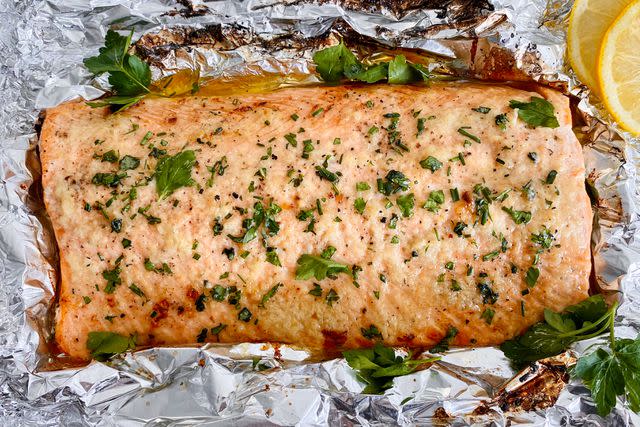Should You Use the Shiny or Dull Side of Foil?
The experts at Reynolds weigh in.

Simply Recipes / Kalisa Marie Martin
My kitchen is never without aluminum foil. From covering bread that's browning too quickly as it bakes to scrubbing dirty pans with a ball of it to leak-proofing my favorite cheesecake in a water bath, foil is a cooking essential. And since foil is sturdy and easily cleaned, instead of tossing it after one use, I reuse it for baking, cleaning, and storing food.
Recently I saw the viral reel (below) that says, "Did you know that the shiny side of foil is for hot food and matte side is for cold?" It also claims that the dull side of foil is non-stick. Have I been using foil wrong all these years? Here's what I found out from the experts.
Why Does Foil Have a Shiny Side and a Dull Side?
The reason foil has a shiny and dull side is due to how it's made, a process called milling. According to the U.S. Department of Agriculture (USDA), two layers of foil are placed on top of each other and squeezed through polished steel rollers to flatten and shape the foil. The two layers are then separated for packaging and distribution.
The side that was in contact with the polished steel rollers is shiny. The other side, where the two layers of foil touch each other, comes out dull. Essentially, one side got buffed more and became shiny.

Simply Recipes / Sally Vargas
Which Side Is Best To Use?
Reynolds, a popular brand of foil, states on its website that "it’s perfectly fine to place your food on either side so you can decide if you prefer to have the shiny or dull side facing out."
Chemist and former food writer for the Washington Post, Robert L. Wolke also wrote in What Einstein Told His Cook that it makes no difference which side of the foil you use. Both claim that the difference between the sides is purely a result of how foil is manufactured.
However, neither explains why it doesn't make a difference.
Over the years, I've noticed food experts reason that the shiny surface is more reflective, bouncing off heat waves, while the dull side will trap heat. And this determines which side should be used.
For example, renowned baker and cookbook author Alice Meldrich recommends baking cookies on a sheet pan lined with foil dull-side up, because it retains more heat in the oven, yielding cookies with a crispier and more golden brown bottom.
Though there is a difference in how much heat the shiny vs. dull side reflects or retains, measured over time and considering the type of heat the oven emits, that difference is negligible and has little to no discernable impact on the food. That's why it doesn't matter which side you use. This is true whether the food is hot or cold.

Simply Recipes / Kalisa Martin
Some Foil Does Have a Non-Stick Side
Regular foil does not have a non-stick side. You have to grease it with cooking spray, butter, or oil to get a non-stick surface.
You can buy non-stick foil that has one side sprayed with a food-safe non-stick coating. Typically, it's the dull side and sometimes it is labeled as non-stick so that it's easy to tell.
The Takeaway
Foil has a shiny side and a dull side because of how it is manufactured. Unless you are using foil that's labeled non-stick, which does have a non-stick side, it does not matter what side you use. Both the shiny and dull sides can be used the same way to cook, freeze, and store food.
Read the original article on Simply Recipes.

 Yahoo Lifestyle
Yahoo Lifestyle 
